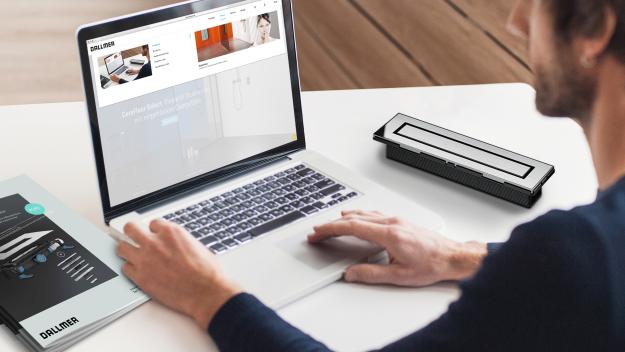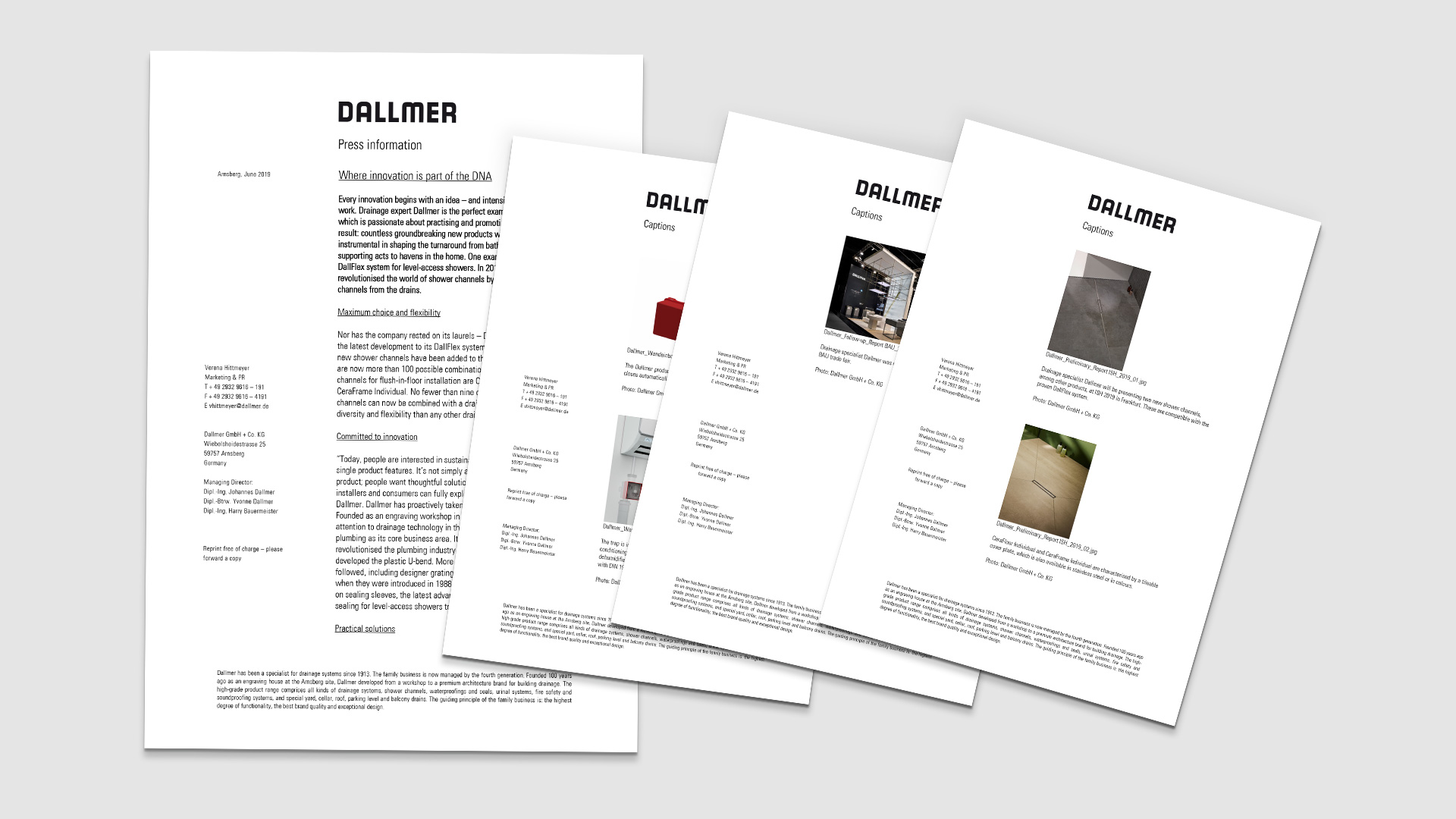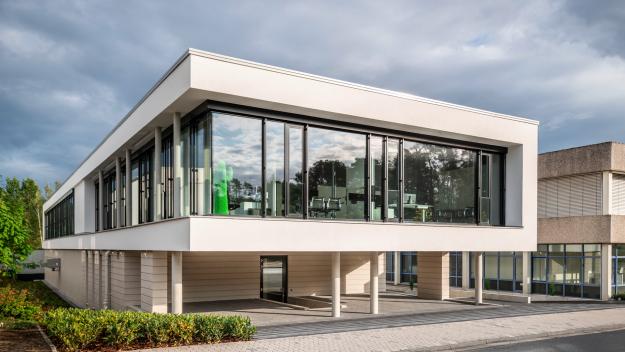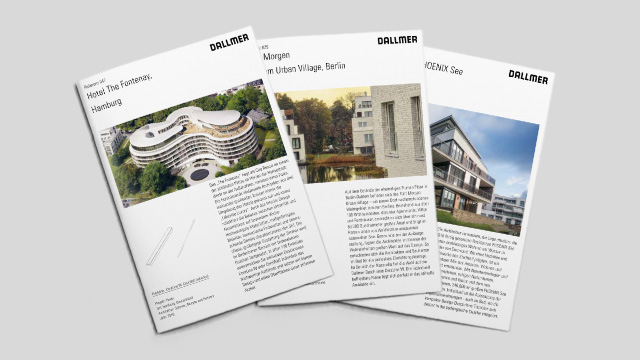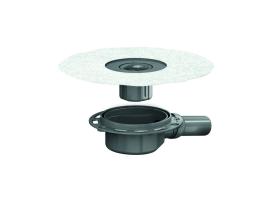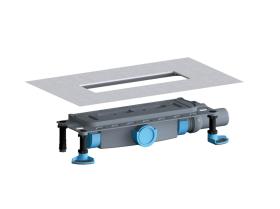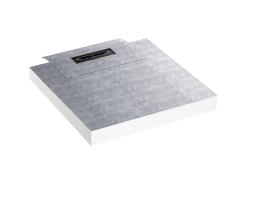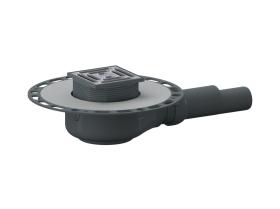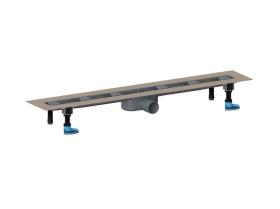Compact Knowledge - Waterproofing standard DIN 18534
At a glance
- DIN 18534
The standard for the waterproofing of buildings has been effective since July 2017 and regulates the waterproofing of interior spaces, which also covers level-access showers. - Uniform and up-to-date
Planners and trade are provided with a helpful directive which covers the latest developments in technology. - Key factors when waterproofing level-access showers
In order to waterproof level-access showers correctly, you have to take into account the type of flange, the width of the flange and the water exposure class.
- Flange
The flange of a floor drain is used to properly connect seal types. - Types of flange
The flange on the drain body can be connected to the sealing sleeve in three ways: via a client-supplied adhesive bond, a factory-fitted connection and a client-supplied clamp connection. - Water exposure classes
Water exposure classes indicate how heavily exposed a specific area is to water and therefore significantly influence the requirements on waterproofing.
Waterproofing standard DIN 18534
The standard DIN 18534 is based on DIN 18195, which regulates the planning and execution of all types of building waterproofing. However, DIN 18195 now only provides the framework for the various building waterproofing sectors, since it was broken down into the standard series 18531 to 18535. These include:
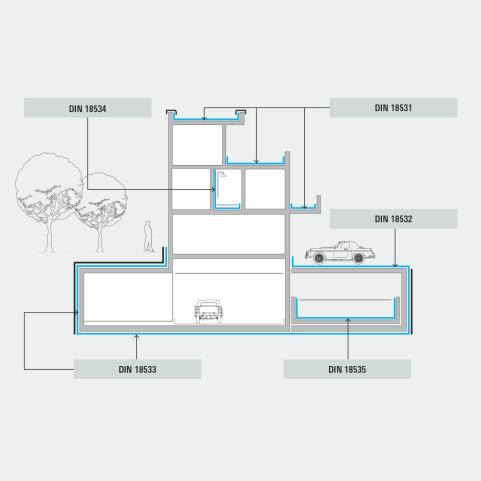
DIN 18531: Waterproofing of non-utilised and utilised roofs, balconies, loggias and walkways
DIN 18532: Waterproofing of concrete areas trafficable by vehicles
DIN 18533: Waterproofing of elements in contact with soil
DIN 18534: Waterproofing for indoor applications
DIN 18535: Waterproofing of tanks and pools
The standard DIN 18534 is therefore decisive when it comes to waterproofing in bathrooms and the waterproofing of level-access showers. It has been effective since 2017. Planners and tradespeople benefit from the standard in two ways: firstly, this standard covers state-of-the-art technology, which means bonded waterproofing is now also finally covered. And while this has proven to be a reliable solution for the waterproofing of wet areas, until now it needed to be contractually regulated as a special structure in each individual case. And secondly, it now provides a binding code of practice. Until now, the waterproofing of interior spaces was regulated by a range of data sheets and guidelines published by the Central Federation for the German Building Industry (ZDB) and by the standard DIN 18195.
Correctly waterproofing level-access showers
The standard offers uniform, up-to-date rules for the waterproofing of buildings. This provides much greater on-site clarity and safety in the execution of waterproofing and a clear-cut allocation of tradespeople to specific tasks. However, DIN 18534 also takes into account the special challenges faced when waterproofing level-access showers. Bonded waterproofing is now recognised as state of the art. When implementing waterproofing according to DIN 18534 additional aspects have to be observed. Above all, what are referred to as the water exposure classes and, when it comes to the level-access shower, the type of flange and the width of the flange of floor drains and shower channels.
Flange and connection types
In order to ensure that the shower channels and floor drains are permanently waterproof, they need to be correctly installed in bonded waterproofing. DIN 18534-3 regulates the structural connection of the flange on the drain body to the sealing sleeve, which is incorporated in the bonded waterproofing. There are three reliable types of connection:
- Client-supplied adhesive connection for a sealing sleeve
The sealing sleeve is glued to the adhesive flange in a watertight manner on site. If the flange is less than 50 mm in width, evidence must be provided that the connection between the adhesive flange and the sealing sleeve has been made using system-compliant sealant adhesive according to the manufacturer's specifications. - Client-supplied clamp connection for a sealing sleeve
The sealing sleeve is clamped in a watertight manner between the fixed flange (≥ 50 mm) of the floor drain and the loose flange (≥ 40 mm). - Factory sealing sleeve connection
The sealing sleeve is connected in a watertight manner to the floor drain in the factory. It has proven to be particularly practical if the sealing sleeve attached in the factory is not joined permanently to the drain body, by clicking it in, until directly before generation of the bonded waterproofing.
Flange widths
In the section "Detail formation" (Section 7.6) of DIN 18534-3, it also states that the "flange width on drainage channels, floor drains and installed parts (…) must be at least 50 mm." However, this does not apply to factory-fitted sealing sleeves. Particularly if floor drains are installed in heavy-duty areas, such as in public in-line showers, the flange width must be a minimum of 50 mm. The sealing sleeve on the adjacent area must also overlap by > 50 mm.
All Dallmer drainage systems for mounting bonded waterproofing comply with DIN 18534.
Requirements for the flange width in accordance with the water exposure class
| Bonding flange width | W0-I | W1-I | W2-I | W3-I | |
| ≥ 30 mm | |||||
| ≥ 50 mm | |||||
| Factory sealing | |||||
Water exposure classes
The various demands made on waterproofing due to the effects of moisture on walls and floors are defined in DIN 18534-1 using four water exposure classes, W0-I to W3-I. The longer an area is exposed to water, and the greater the volume of water, the greater the level of waterproofing required in order to prevent moisture damage.
Water exposure classes acc. to DIN 18534
| Water exposure class | Explanation | Requirement for seal | Example |
| W0-I low | Surfaces with infrequent exposure to spry water | No further seal is required if surfaces are sufficiently water resistant | Guest WCs without shower or kitchen floors without floor drain |
| W1-I moderate | Surfaces with more frequent exposure to spray water or infrequent exposure to service water, without intensification due to accumulated water | No special requirements unless the moisture can penetrate into sensitive sublayers. However, practical experience shows that a seal as per the standard is always recommendable. | Wall above bathtub or in the shower |
| W2-I high | Surfaces with frequent exposure to spray water and/or service water, occasionally intensified by accumulated water above all on the floor | Seal according to standard | Floor surfaces of level-access showers |
| W3-I very high | Surfaces with very frequent or continuous exposure to spray water and/or service water and/or water from intensive cleaning methods, intensified by accumulated water | Seal according to standard | Commercial kitchens, showers and pool edging in the swimming pool |
In private bathrooms the level-access, fully tiled shower in the floor area is water exposure class W2-I. In this case the waterproofing must be implemented with crack-bridging mineral sealing slurries or reaction resins. Alternatively, sheet waterproofing is also suitable. However, waterproofing with polymeric dispersion coatings are only suitable for the wall area in water exposure class W2-I. In in-line showers installed in sports clubs or industrial buildings, both floors and wet walls fall under water exposure class W3-I, whereas the "splash area" in front of the installation is water exposure class W2-I.
Water exposure classes in private bathrooms:
The floor areas of level-access showers are subject to heavy-duty exposure.
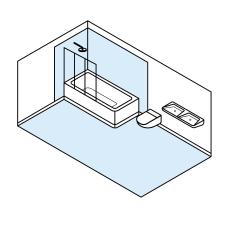
Bathroom with bathtub with shower head and shower enclosure
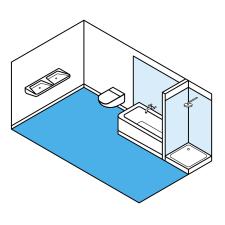
Bathroom with bathtub without shower head with shower tray without shower enclosure
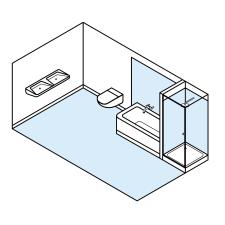
Bathroom with bathtub without shower head with shower tray with shower enclosure
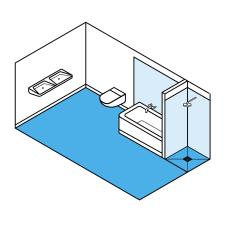
Bathroom with bathtub without shower head with level-access shower without
shower enclosure
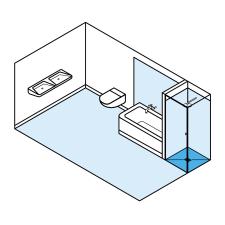
Bathroom with bathtub without
shower head with level-access shower with shower enclosure

W0-I

W1-I

W2-I
Standard-compliant solutions
Dallmer has been a key driver of the technical development that is now reflected in DIN 18534. The required flange width for shower channels and floor drains of at least 50 mm, for example, has been a standard at Dallmer for years. That's why installation and waterproofing are easy to implement with Dallmer products, as is demonstrated here using the examples of the DallFlex and DallDrain drain bodies.
With the DallFlex and DallDrain drain bodies the clear separation of trades so valued by practitioners remains intact during installation: the plumber installs the drain on the unfinished floor and connects it directly to the drainpipe. The sealing sleeve with the required width is then just clipped into the housing prior to application of the bonded waterproofing.
If the drain is being fitted in an area with water exposure class W3-I – such as public in-line showers – the flange width and overlapping must meet more stringent requirements. Yet the DallFlex and DallDrain drain bodies still comply with the standards as the width of the sealing sleeve around the drain is generally 100 mm.
DallFlex drain body
For installation with the shower channels of the DallFlex system family
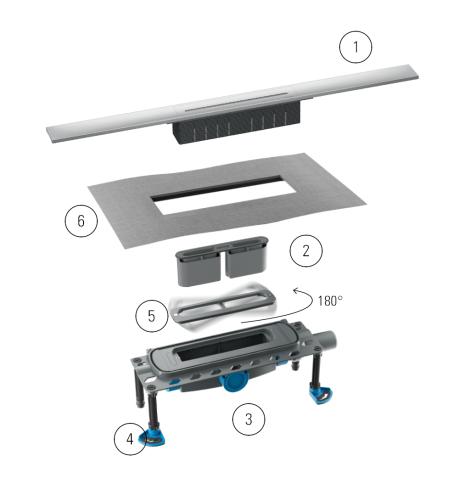
- Numerous shower channels make for almost unlimited variation options
- Easy-to-remove trap insert for quick cleaning; easy access to wastewater pipe
- Tool-free positioning of drain outlet on three sides, moving ball joint for stress-free connection to the wastewater pipe
- Mounting stands for acoustic decoupling and height adjustment
- Asymmetrical interchangeable frame for adaptation to various wall covering thicknesses from 12 – 32 mm, even after installation in the screed
- Flexible, click-in sealing sleeve for mounting bonded waterproofing according to DIN 18534
DallDrain drain body
Point drainage which can be configured flexibly for every installation scenario
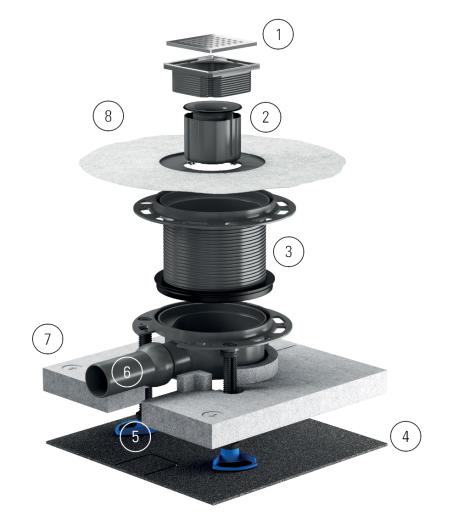
- Various grating attachments
- The removable two-piece odour trap is easy to clean and guarantees optimum hygiene; easy access to wastewater pipe
- The raising piece with backflow seal can be shortened to any length and makes for exact height offset
- Sound insulation mat (increased sound insulation from a build height of 59 mm and above)
- Mounting stands for acoustic decoupling and height adjustment
- The moving outlet facilitates tension-free installation
- The two-piece installation aid saves time when installing
- Flexible, click-in sealing sleeve for mounting bonded waterproofing according to DIN 18534
Tried-and-tested combinations: quick and reliable
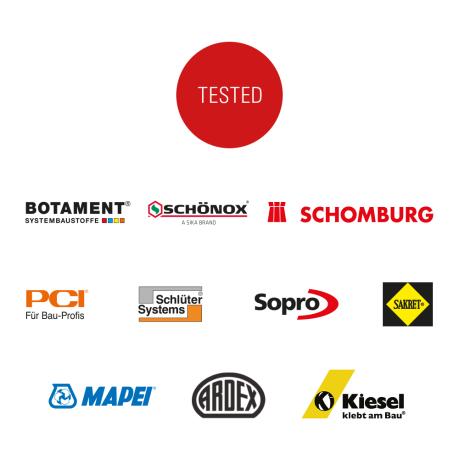
For the DallFlex and DallDrain system families we provide a General Building Supervisory Authority Test Certificate or the manufacturer's approval on the compatibility with the liquid seals and sheet seals of a number of manufacturers.
Glossary
Bonded waterproofing is necessary because coverings with joins, such as tiles, panels and natural stone, are not waterproof by themselves. The basis of bonded waterproofing is a paint/filler seal coating or a waterproofing membrane. The tiler lays panels or tiles using the thin bed method. Bonded waterproofing must be implemented everywhere where splash water or service water occurs. In the process the walls are sealed up to 20 cm above the highest possible water outlet or the area of the expected spray water.
Plastic and cement mortar combinations which are applied with a trowel or sprayed on. Sealing slurries are used everywhere where particularly high demands are placed on moisture protection.
Regulates the planning and design of the waterproofing of buildings. This standard was superseded in July 2017 by DIN 18534.
This term refers to water that has already been used for something – in this case a shower – and can be used again, whereby the issue of re-use plays a greater role in industry than in domestic households. Service water must meet certain minimum hygiene standards, even if it is not suitable for drinking.
Relevant products
Downloads
Further downloads
Brochures, references, data sheets, etc. are available in our Download section.
Dated: July 2022

